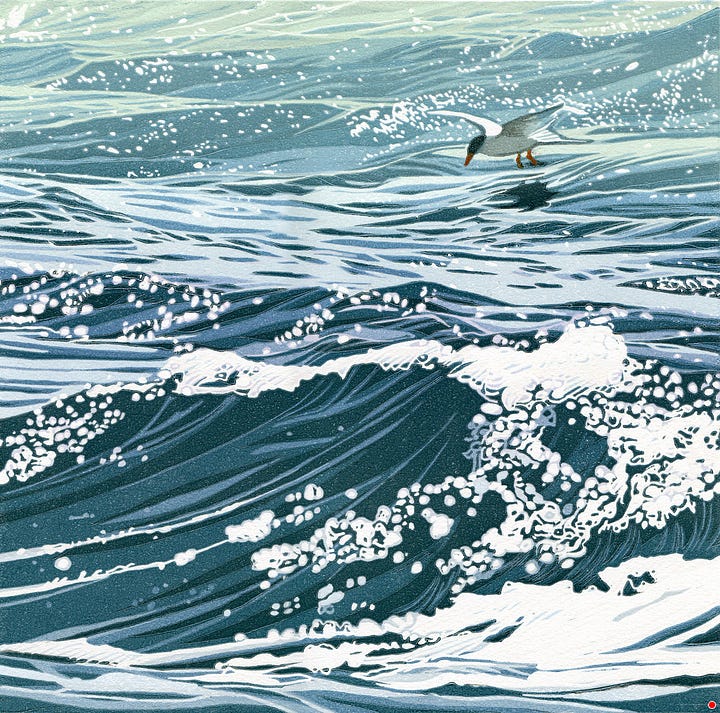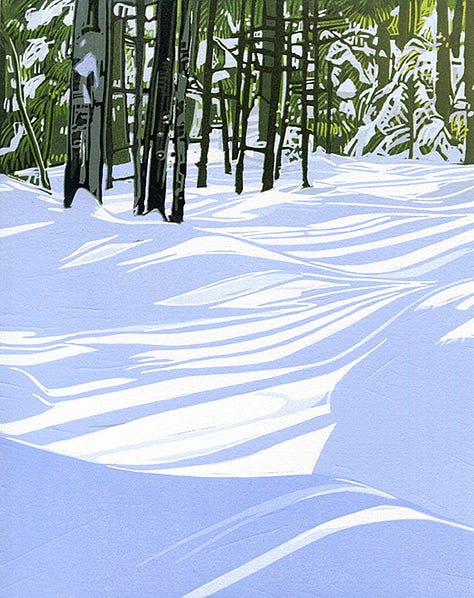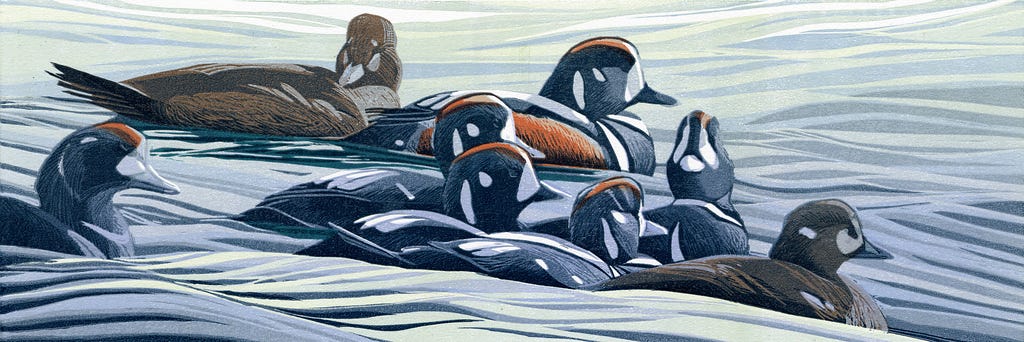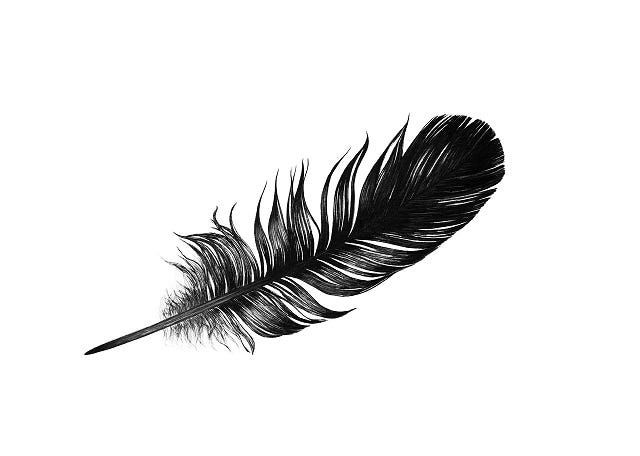Hello everyone:
As an expression of gratitude for the Field Guide community, and in recognition of the frequent heaviness of the work at hand, I’m offering you something light, quick, and beautiful on this holiday break. Please enjoy.
As always, please remember to scroll past the end of the essay to read this week’s curated Anthropocene news.
Now on to this week’s essay:
Our friend Sherrie York lives nearby in a small house tucked away on the edge of field and forest, here on one of midcoast Maine’s many peninsulas. In it, she works quietly and very, very patiently on her remarkable linocut prints of birds, flowers, and other natural wonders she encounters on her walks in this wondrous place. I’m particularly fond of her work with birds on the water.
If these prints were paintings, they’d still be marvelous, but to me what Sherrie does with the linocut process to produce these subtle, joyful, textured portraits of the wild world is simply astonishing. Linocut printmaking is ridiculously complicated, a high-wire act that requires an artist’s vision, a draftsman’s drawing skills, a painter’s ability to build an image up through multiple layers of color, and a sculptor’s capacity for creation through subtraction.
And there’s one more twist: What she carves is not what we’ll see, because the linocut is a mirror image of the print.


There is an enormous amount of time invested in each image, time that passes in steps slowly and then suddenly, slowly and then suddenly. Every color you see in these prints represents a unique stage in the process that, once set, cannot be revisited, because all areas with that color are laboriously carved away by hand before the next color can be worked on. Or as Sherrie writes, “the artist carves away any areas of the block that they do not want to print.” She can modify a specific color during its stage, but not after. The image is printed not just once at the end, but over and over through color layer after color layer, for each one of the limited number of prints she’ll make from it. And, after each layer is inked on, a print must hang and dry, sometimes for days.
On the Process page of her website, Sherrie begins with a simple definition of a linocut - “a type of relief print created by applying ink to the raised surface of a carved piece of linoleum, and using pressure to transfer the inked image to paper” - before going on to provide more detail. One thing she clarifies is the idea of a linocut “print”: unlike the unlimited copies of a painting, a linocut print is actually an original, unique artwork.
There’s a stripped-down description of the linocut process on the Process page, but for a much better sense I recommend her cheerful 15-minute video, Reduction Linocut Process: Columbine.
I love the presence of each bird in her images. They belong in the world, and in the world Sherrie has created.



She works wonders with birds in other settings…



with landscapes…



and with the textures of life that we don’t pay attention to until an artist reveals them to us, like this remarkably detailed glimpse into the patterns of a tidal pool:
In writing about the inspiration behind this particular print, Sherrie reminds us that
The intertidal zone is a special and constantly changing place. Completely underwater for parts of each day, and exposed to the extremes of heat, cold, wind, rain, and snow in between, organisms that make the intertidal zone their home must be resilient and adaptable... holding fast when necessary, and moving or letting go when the time comes.
I see resilience and adaptability also in Sherrie’s complex linocut process, crafting in incredible detail one day and then, as the ink dries and the work reveals itself in slow stages, letting the art take on a life of its own.
And, in the bigger picture, both the intertidal zone and the nature of Sherrie’s work speak to this difficult, turbulent moment in both human and Earth history that you and I are awash in. I doubt I’m the only one who feels the tide of news and Anthropocene science surge roughly over me throughout the day, leaving me either underwater or exposed to the extremes of the new world we’re forging from our mistakes.
And that’s where good art, and good acts, undertaken with the patience required, become necessary. To protect, conserve, rewild, and otherwise respect the inherent beauty of the living world, we need to infuse our communities with a hard-working creativity that feeds the zeitgeist which in turn helps shift society toward good policy. I make no claim here for the power of art to fix the Anthropocene, but that doesn’t make it any less necessary.
You can’t swing a cattail here in midcoast Maine without hitting one of the boat builders, painters, potters, musicians, sculptors, craftspeople, and writers who call the nooks and crannies of this coastline home. Here, as among all the peoples of the world, so many of us are trying to live reasonable, less harmful lives that are respectful of the community of life that has nurtured our species.
These Maine artists are all doing beautiful work, but I want to highlight Sherrie’s images here because her focus isn’t a human view of a human world ornamented by nature. She looks at the real world in and of itself, and helps us to see it, to move closer to it, step by step.


You can read more about Sherrie and her award-winning work on her website. Many of these prints - and plenty of others - are available for purchase there, under the Portfolios tab. Enjoy.
Thanks for sticking with me.
In other Anthropocene news:
From DeSmog, an inspiring interview with Tzeporah Berman, the founder and chair of the Fossil Fuel Non-Proliferation Treaty Initiative. The Fossil Fuel Treaty, modeled on the Nuclear Non-Proliferation Treaty is an intriguing strategy for fighting the uphill battle against the fossil fuel industry. Please take a look. You can expect me to write about this at length someday.
From Carbon Brief, a comprehensive analysis of every significant outcome at the COP29 U.N. climate conference in Azerbaijan.
From the Times, a really good overview of what’s at stake and what the path forward might be at the critical global conference to address plastic pollution. The headline lately has been that the U.S. pulled back at the last minute from its support for a binding treaty that requires a reduction in plastics production, but the solution at this final meeting might be for much of the world to simply go ahead and sign that treaty anyway. The U.S., after all, has failed to ratify a very long list of international treaties it signed onto over the last century, but some of those treaties have nonetheless been successful.
And, as always,
at has the best round-up of biodiversity news anywhere. This week, he frames up the relevant news from the climate and plastics conferences, and provides his usual deep and well-organized array of links to biodiversity stories and news from around the world.From
and , a brilliant short essay on the conservation movement’s problematic focus on scarcity - e.g. the wolf population has crashed and must be revived - and not enough on abundance, as when the wolf population rebounds and conflicts with human interests intensify. She explains thatthis kind of significant, sustained recovery has inevitable consequences for both humans and host ecosystems. If conservationists don’t have the multidisciplinary research and other resources they need to address those consequences, the species is likely to be persecuted or confined to inadequate habitat or both. Even dramatic recoveries can easily be arrested or reversed.
I want to highlight this one again. From Hakai, “The Other Side of the World’s Largest Dam Removal,” a long-form exploration of the local opposition to what seems to many of us to be one of the most wonderful rewilding projects in the world: the removal of four big dams on the Klamath River, bringing salmon and other free-swimming fish back into hundreds of miles of headwaters. If you have the time to read a long, thoughtful, necessary article about the deeply human story behind the opposition to Klamath dam removal, please do. It speaks also to the fragmented, difficult politics of 21st century America.
From the New Yorker, an excellent report from New Caledonia - a French possession in the South Pacific - and the increasing tension between the desperate need to protect one of the most biodiverse and unique plant communities on Earth and the noisy, desperate search for minerals to power the “clean” energy transition. New Caledonia is small but contains an absurd portion of the world’s nickel supplies beneath forest communities that exist nowhere else.
For those of you who have been grateful for Heather Cox Richardson’s political and historical perspective in her “Letters from an American” newsletter here on Substack (especially during the first Trump administration), and are looking for an environmental equivalent, please check out
’s new Owl in America series from . Rebecca calls it “a series of letters chronicling the next four years from the perspective of an environmental lawyer.” A recent letter highlighted 1) the extinction of the slender-billed curlew, 2) the Fish and Wildlife proposal to protect 1.6 million acres of habitat for the rusty-patched bumblebee, 3) the EPA’s efforts to deal with an aquatic toxin used in all car tires, and 4) the wonderful success of salmon immediately moving upstream from former dam sites on the Klamath River after a century of blockage.From
at , his excellent review of the fascinating book Indigenous Continent by Pekka Hämäläinen, a comprehensive history of Native American history in North America. I haven’t read the book, but I now feel like I really should.From Resilience, if for some reason during this holiday period you’re looking for a dark, not-particularly-hopeful view of the human future in an ecological context, with a deceptively optimistic-sounding title - “Envisioning a Livable Future,” try this overview from Richard Heinberg, Senior Fellow at the Post Carbon Institute.









Thank you for sharing the work of your artist friend. Each print is more marvelous than the last. I’ve done a tiny bit of linoleum block printing — enough to be in absolute awe at the beautiful detail in these. And her attentive eye. Everything from individual blades of sea grass to bubbles on water to the sky reflected in rippled geometry behind a trio of moving ducks. What a delight.
I am thankful that you've introduced this marvelous artist to me! Much Gratitude!!!